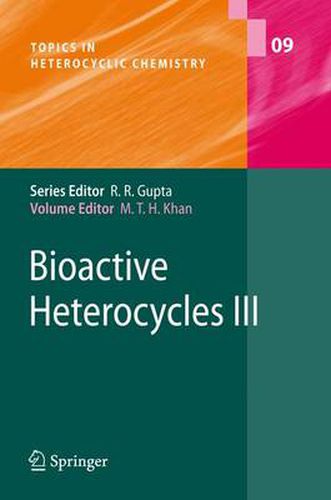Readings Newsletter
Become a Readings Member to make your shopping experience even easier.
Sign in or sign up for free!
You’re not far away from qualifying for FREE standard shipping within Australia
You’ve qualified for FREE standard shipping within Australia
The cart is loading…






Bioactive Heterocycles III provides readers with a comprehensive overview of the most recent breakthroughs in the ?eld of heterocycles. This volume contains 8 chapters written by experts in their respective ?elds from all over the world. The chapters summarize years of extensive research in each area, andprovideinsightinthenewthemesofnaturalproductresearch.Manyofthe contributors illustrate their laboratory experiences. It’s obvious that readers will gain exciting and essential information fromthe volume. In the ?rst chapter, Kayser et al. describe the chemistry, biosynthesis and biological activities of artemisinin, one of the most promising antimalarial molecules, and its related natural peroxides. They present new strategies of producing artemisinin that utilize fascinating technologies. as Additionally, thepharmacokineticpro?leandthedevelopmentofnewdrugdeliverysystems onPlasmodium infected erythrocytesare presented . Khan describes some aspects of sugar-derived heterocycles and their p- cursors which are utilized as the inhibitors against glycogen phosphorylases (GPs), and are responsible for the release of mono-glucose from poly-glucose (glycogen) in the second chapter. The inhibitors of GP could help to stop or slowdownglycogenolysisaswellasglucoseproduction.Ultimately, thewhole processwill result in the recovery fromdiabetes of NIDDMpatients. In his contribution, Verma studies quantitative structure-activityrelati- ship (QSAR) and proposes several interesting QSAR models of heterocyclic molecules having cytotoxicactivities against different cancer cell lines, which couldin turn clarify the chemical-biologicalinteractions ofsuch compounds. Alamgir et al., in the fourth chapter, review the recent progress of the synthesis, reactivity and biological activities of benzimidazoles. Additionally, they describe several new techniques and procedures for the synthesis of the same scaffold. Inthe?fthchapter,KhanreviewstheessentialroleoftheenzymeTyrosinase in human melanin production, covering various related clinical problems.
$9.00 standard shipping within Australia
FREE standard shipping within Australia for orders over $100.00
Express & International shipping calculated at checkout
Bioactive Heterocycles III provides readers with a comprehensive overview of the most recent breakthroughs in the ?eld of heterocycles. This volume contains 8 chapters written by experts in their respective ?elds from all over the world. The chapters summarize years of extensive research in each area, andprovideinsightinthenewthemesofnaturalproductresearch.Manyofthe contributors illustrate their laboratory experiences. It’s obvious that readers will gain exciting and essential information fromthe volume. In the ?rst chapter, Kayser et al. describe the chemistry, biosynthesis and biological activities of artemisinin, one of the most promising antimalarial molecules, and its related natural peroxides. They present new strategies of producing artemisinin that utilize fascinating technologies. as Additionally, thepharmacokineticpro?leandthedevelopmentofnewdrugdeliverysystems onPlasmodium infected erythrocytesare presented . Khan describes some aspects of sugar-derived heterocycles and their p- cursors which are utilized as the inhibitors against glycogen phosphorylases (GPs), and are responsible for the release of mono-glucose from poly-glucose (glycogen) in the second chapter. The inhibitors of GP could help to stop or slowdownglycogenolysisaswellasglucoseproduction.Ultimately, thewhole processwill result in the recovery fromdiabetes of NIDDMpatients. In his contribution, Verma studies quantitative structure-activityrelati- ship (QSAR) and proposes several interesting QSAR models of heterocyclic molecules having cytotoxicactivities against different cancer cell lines, which couldin turn clarify the chemical-biologicalinteractions ofsuch compounds. Alamgir et al., in the fourth chapter, review the recent progress of the synthesis, reactivity and biological activities of benzimidazoles. Additionally, they describe several new techniques and procedures for the synthesis of the same scaffold. Inthe?fthchapter,KhanreviewstheessentialroleoftheenzymeTyrosinase in human melanin production, covering various related clinical problems.